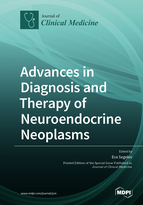Advances in Diagnosis and Therapy of Neuroendocrine Neoplasms
A special issue of Journal of Clinical Medicine (ISSN 2077-0383). This special issue belongs to the section "Oncology".
Deadline for manuscript submissions: closed (30 September 2019) | Viewed by 33482
Special Issue Editor
Special Issue Information
Dear Colleagues,
This Special Issue is dedicated to neuroendocrine neoplasms (NENs), a category of malignancy that demonstrates wide clinical heterogeneity, posing major challenges in diagnosis and management. There have been significant advances in the field of NEN genomics, pathology, imaging, and treatment over the past five years. NENs are examples of rare tumours (although their incidence and prevalence are rising) where international collaborative efforts have allowed the generation of high-level evidence to guide optimal patient-centred care. This issue presents both reviews and original papers to provide a comprehensive state-of-the-art understanding of this fascinating disease.
Prof. Eva Segelov
Guest Editor
Manuscript Submission Information
Manuscripts should be submitted online at www.mdpi.com by registering and logging in to this website. Once you are registered, click here to go to the submission form. Manuscripts can be submitted until the deadline. All submissions that pass pre-check are peer-reviewed. Accepted papers will be published continuously in the journal (as soon as accepted) and will be listed together on the special issue website. Research articles, review articles as well as short communications are invited. For planned papers, a title and short abstract (about 100 words) can be sent to the Editorial Office for announcement on this website.
Submitted manuscripts should not have been published previously, nor be under consideration for publication elsewhere (except conference proceedings papers). All manuscripts are thoroughly refereed through a single-blind peer-review process. A guide for authors and other relevant information for submission of manuscripts is available on the Instructions for Authors page. Journal of Clinical Medicine is an international peer-reviewed open access semimonthly journal published by MDPI.
Please visit the Instructions for Authors page before submitting a manuscript. The Article Processing Charge (APC) for publication in this open access journal is 2600 CHF (Swiss Francs). Submitted papers should be well formatted and use good English. Authors may use MDPI's English editing service prior to publication or during author revisions.
Keywords
- neuroendocrine tumours
- functional and non-functional endocrine tumours
- somatostatin receptors
- genomics
- targeted therapy
- clinical trials







